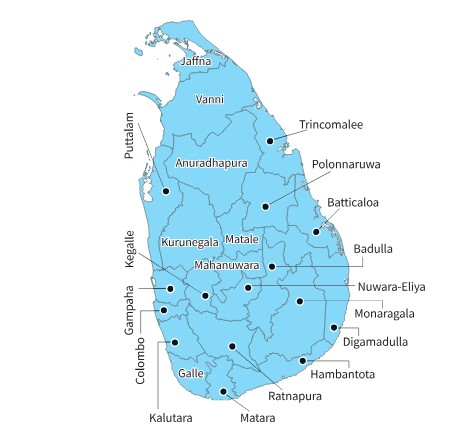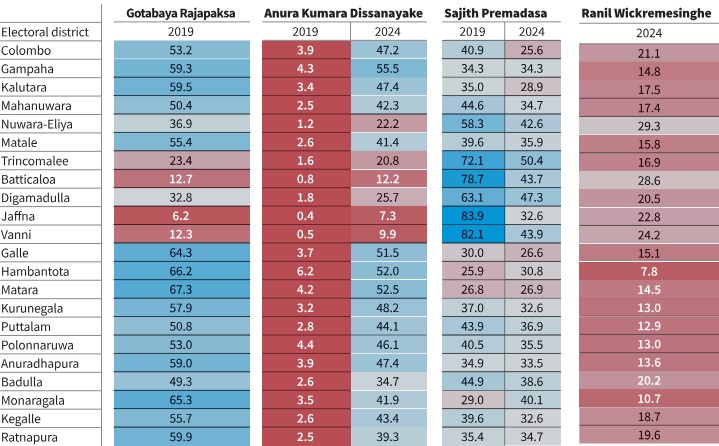By T. Ramakrishnan/The Hindu
Chennai, September 26: For the first time since 1978, in presidential elections in Sri Lanka, no candidate won more than 50% of the total votes in the first round of counting. Anura Kumara Dissanayake of the Janatha Vimukthi Peramuna (JVP), put up under the banner of the National People’s Power (NPP), obtained 42.31%. He was declared the winner after the second count, which tallied voters’ second and third choice candidates. This too was historic: no election in Sri Lanka has ever progressed to the second round of counting.
Table 1 shows overall % share of votes secured by major candidates in the 2019 and 2024 presidential elections
An analysis of the votes obtained in the first round of counting, excluding preferences, reveals that seven out of 22 electoral districts in the island nation — three each in the Western Province (Colombo, Gampaha, and Kalutara) and Southern Province (Galle, Matara, and Hambantota), and one in the North-Western Province (Kurunegala) — account for 57% of the vote share of Mr. Dissanayake.
Map shows the 22 electoral districts of Sri Lanka

Coincidentally, in 2019, the collective share of the seven districts in the total votes of Mr. Dissanayake’s predecessor, Gotabaya Rajapaksa, was about 55%. The similarity does not stop there. As in the case of the former president five years ago, Mr. Dissanayake too got more than 50% of the votes in Gampaha and the three districts of the Southern Province. In these four districts, he exceeded the 50% mark, whereas Mr. Rajapaksa achieved this in 11 more districts. There is a difference of nearly 10 percentage points between the vote share that Mr. Dissanayake secured this time (42.31%) and what Mr. Rajapaksa secured in 2019 (52.25%). What is remarkable is that five years ago, Mr. Dissanayake got a vote share of merely 3.16%. He has clearly reaped the political dividends from the Janatha Aragalaya, which arose due to an economic crisis in 2022.
Table 2 shows the overall district-wise % share of votes secured by major candidates in the 2019 and 2024 presidential elections. Figures in %

Last election, of the about 4.18 lakh votes that Mr. Dissanayake received, the share of the seven districts was around 55%. The difference now is that the JVP-NPP has been able to spread its wings in every other district. In Matale in the Central Province, for instance, Mr. Dissanayake had received 2.6% of the votes in 2019; this rose to 41.37% in 2024. It was in Matale where several incidents of human rights violations were reported to have taken place in 1989 during the armed conflict between the Ranasinghe Premadasa-led United National Party (UNP) government and the JVP, which had organised an insurrections in 1971 and in 1987-89.
Even though Mr. Dissanayake lagged behind his immediate rival, Sajith Premadasa, of the Samagi Jana Balawegaya (SJB), in the districts with a substantial number of ethnic minorities, he improved his performance from 2019. In Digamadulla (Ampara) in the East, for instance, he did not get even 2% of the votes in 2019; this time, he secured more than 25%. Yet, the JVP chief could not secure an outright victory unlike his predecessors. The acceptability of his party remains an issue with a majority of voters of the country.
Mr. Sajith, who lost the presidential election for the second consecutive time, could have emerged the winner but for the presence of his one-time colleague in the UNP, former President Ranil Wickremesinghe, in the fray. Compared to 2019, Mr. Sajith’s vote share went down by about 10 points, to 32.8%, and Mr. Wickremesinghe, as an independent candidate, garnered around 17%. To make Mr. Sajith’s position more difficult, a ‘common Tamil candidate’, P. Ariyanethiran, who was supported by many parties and groups, secured about 2.26 lakh votes, two-thirds from Jaffna and Vanni districts in the North, and polled 1.7%. There was no such candidate last time.
END

























































